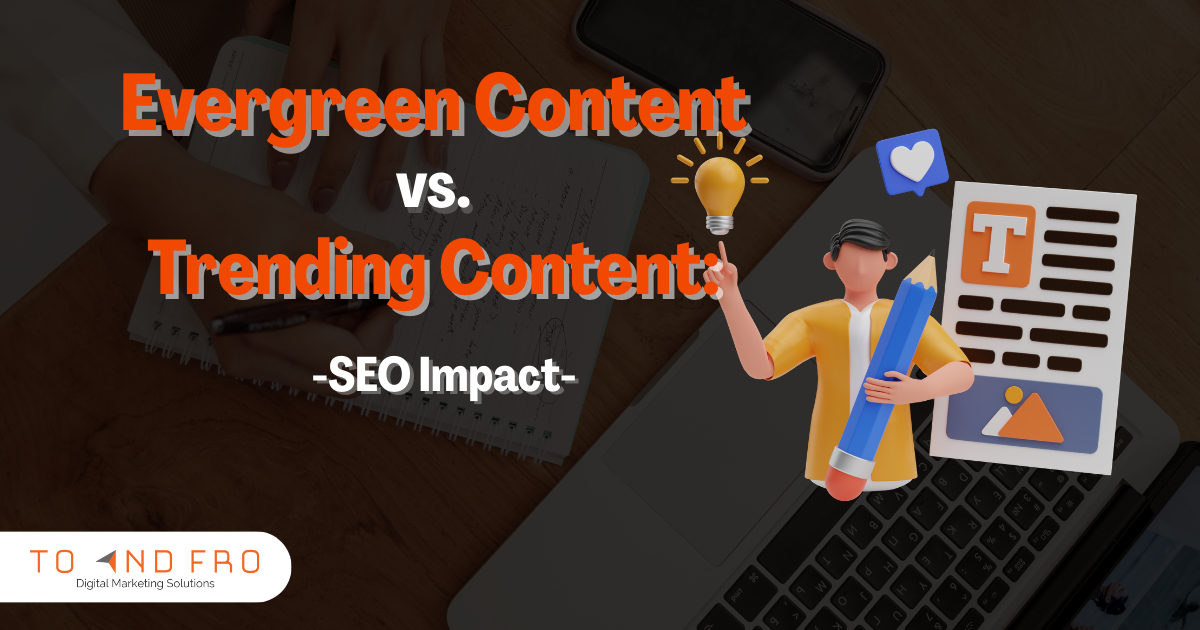Introduction
Creating high-performing content is a cornerstone of effective SEO. While most businesses focus on optimizing technical aspects and backlinks, content strategy often makes the difference between average visibility and outstanding organic traffic.
One key decision in content planning is choosing between evergreen content and trending content. Both serve different purposes and have unique SEO impacts, but how do you use them strategically?
In this blog, we’ll break down the definitions, benefits, and SEO implications of each, and explain how you can use both types of content to maximize your organic reach and long-term visibility.
What is Evergreen Content?
Evergreen content refers to articles or pages that remain relevant and valuable over time. These pieces are not tied to a specific news cycle or event. Instead, they provide timeless information that answers ongoing user queries.
Examples of evergreen content:
- “How to Do Keyword Research for SEO”
- “A Beginner’s Guide to Link Building”
- “What Is Domain Authority and Why Does It Matter?”
This kind of content delivers value continuously and aligns well with long-term SEO goals. When optimized correctly, it can generate consistent traffic, attract backlinks, and maintain strong rankings for months or even years.
What is Trending Content?
Trending content is built around current events, hot topics, or temporary spikes in interest. These pieces are designed for fast publishing and high visibility in the short term, often timed with recent developments or viral trends.
Examples of trending content:
- “What the 2025 Google Algorithm Update Means for SEO”
- “New Features in Google Search Console You Should Know”
- “Latest SEO Trends Every Marketer Should Watch This Month”
While trending content doesn’t have a long shelf life, it can generate quick wins in terms of traffic and engagement especially when paired with strong social media promotion.
The SEO Benefits of Evergreen Content
1. Stable Organic Traffic
Evergreen content continues to attract visitors long after it’s published. Once indexed and ranked, these pages can deliver sustainable traffic with minimal ongoing effort.
2. Improved Backlink Potential
Because evergreen content stays relevant, it’s more likely to be referenced or cited by other websites, increasing your domain authority through natural backlinks.
3. Better ROI
Creating evergreen content is resource-efficient. You invest in it once, and it continues to provide value. This leads to higher returns on content investment, especially when compared to the short-lived nature of trending content.
4. Ranking Stability
Google rewards content that provides long-term value. Evergreen posts are more likely to maintain their rankings, especially if they’re periodically refreshed with updated statistics or insights.
The SEO Benefits of Trending Content
1. Quick Traffic Surges
Trending content often ranks quickly, especially if it’s published soon after the event occurs. This leads to a rapid increase in impressions and clicks, perfect for promotional campaigns or brand awareness.
2. Boosted Engagement
Because trending topics are top-of-mind, users are more likely to engage, share, or comment on them—especially on social media platforms. This can create short bursts of viral traffic.
3. Featured Snippets and News Visibility
Timely content has the potential to appear in Google’s Top Stories, featured snippets, or Google Discover premium placements that can significantly increase click-through rates.
4. Brand Authority
Covering industry news and updates positions your brand as a thought leader. It tells your audience you’re paying attention and staying relevant.
How to Use Both Content Types in Your SEO Strategy
1. Build Your Foundation with Evergreen Content
Start by creating in-depth, optimized articles that answer common search queries in your niche. Think of topics that always remain relevant—and ensure they include updated information, internal links, and keyword variations.
2. Capitalize on Trends with Timely Content
Monitor industry news, algorithm changes, and viral discussions. Tools like Google Trends, Twitter, and Reddit can help you spot opportunities. Publish content that provides quick insights or your unique take on these topics.
3. Link Trending Posts to Evergreen Resources
Use your trending articles to drive traffic to your evergreen content. For example, a post about Google’s latest update can link to a comprehensive guide on core web vitals or SEO audits.
4. Update Evergreen Content Periodically
Just because content is evergreen doesn’t mean it’s untouchable. Revisit top-performing pages every 6–12 months to refresh statistics, remove outdated examples, and improve readability. This helps maintain rankings.
5. Measure Performance Separately
Use analytics tools to track how each content type performs. Metrics like:
- Organic traffic
- Bounce rate
- Session duration
- Keyword rankings
- Backlinks
…can help determine whether your SEO strategy is balanced and effective.
Common Mistakes to Avoid
- Publishing only one type of content: Relying solely on evergreen or trending posts limits your SEO potential.
- Neglecting content updates: Even evergreen pages need occasional refreshes.
- Ignoring search intent: Trends change fast; ensure content aligns with what users are actually searching for.
- Skipping internal linking: Link trending posts to evergreen pages to build a content ecosystem.
Conclusion
In the evolving world of SEO, success isn’t just about ranking for keywords—it’s about serving the right content at the right time.
Evergreen content lays the foundation for consistent, long-term growth. Trending content drives bursts of visibility and keeps your brand relevant. When combined strategically, they help you build a resilient SEO strategy that stands the test of time and algorithm updates.
Whether you’re managing a blog, an e-commerce platform, or a corporate site, blending both content types ensures you’re visible when people are searching—and relevant when they need you most.
Need help crafting a powerful SEO content strategy? Contact us today and let’s build content that works—today and tomorrow.






